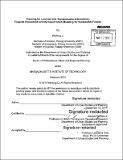| dc.contributor.advisor | Joseph Ferreira, Jr. | en_US |
| dc.contributor.author | Li, Weifeng, Ph. D. Massachusetts Institute of Technology | en_US |
| dc.contributor.other | Massachusetts Institute of Technology. Department of Urban Studies and Planning. | en_US |
| dc.date.accessioned | 2015-07-17T19:47:47Z | |
| dc.date.available | 2015-07-17T19:47:47Z | |
| dc.date.copyright | 2015 | en_US |
| dc.date.issued | 2015 | en_US |
| dc.identifier.uri | http://hdl.handle.net/1721.1/97799 | |
| dc.description | Thesis: Ph. D. in Urban and Regional Planning, Massachusetts Institute of Technology, Department of Urban Studies and Planning, 2015. | en_US |
| dc.description | Cataloged from PDF version of thesis. | en_US |
| dc.description | Includes bibliographical references (pages 151-155). | en_US |
| dc.description.abstract | Recent research has begun generating a much richer, activity-based behavioral framework to replace the conventional aggregate, four-step approaches. However, to date, the framework remains to be completed, at least enough to provide a robust behavioral foundation that incorporates household long-term behaviors with routine travel and activity patterns. The objective of this research is to explore aspects of activity-based urban modeling that could assist in understanding changing land use and transportation interactions as information technologies enable more complex measurement and modeling, and alter the economics of urban transportation by improving last-mile logistics and facilitating car sharing. The research focuses on specific issues and strategies for developing household, quasi-activity-based, urban modeling prototypes that could simulate the impacts of transport innovations in metropolitan areas. In our implementation and development of the Lisbon model, we started with case 0 first - the four-step travel demand model without considering any land use change. Then given the considerations of data and modeling purpose, what began as a standard version of the UrbanSim model linked to the four-step travel demand model (in Case 1) has evolved into a modified version of the UrbanSim connected to a uniquely formulated tour-based travel model (in Case 2) that not only adjusted the model specification for certain components, but also changed some of the assumptions about household behavior and heterogeneity. The modified UrbanSim model suggests some improvement over the standard version, in differentiating the accessibility for different types of households. However, it is still far from the considerations of household interactions that many planners consider important in the household long-term choices. One key objective of the research is to improve the ability of the models to simulate the impacts of transportation innovations on household-level activity patterns and residential location choice in metro Lisbon. Since transportation innovations and economic restructuring can trigger substantial changes in place/space/household interactions, household-level adjustments can involve changes in car ownership, trip chaining, repackaging of household trips and the like. Therefore, I propose an accessibility indicator that addresses these considerations when evaluating the attractiveness of destinations and modes. The indicators are measured at the household level and facilitate micro-simulation of residential location choice while accounting for household-specific trip chaining, scheduling, and mode choice options. This household quasi-activity- based urban modeling framework (Case 3), represents a progression of behavioral models that capture observably significant behavioral differences in Lisbon. In the simulation experiments, the quasi-household-activity-based urban modeling framework (Case 3) is applied only for two-worker households for which sufficient activity data are available in Lisbon. The quantitative results from simulating the urban development impacts of the proposed policy changes in the Lisbon Metropolitan in next 25 years under Case 0, Case 1, Case 2 and Case 3 demonstrate the progression of experiments with alternative strategies for incorporating key activity-based elements into LUTE models. The main contributions of the dissertation include the development and implementation of quasi-activity-based modeling framework and specific techniques to assess the impacts of transportation innovations and energy and environmental constraints on urban development patterns. This represents an alternative approach to the traditional land use and transportation interaction research and overcomes some major obstacles to model household activity and mobility. It also has significant applications for transportation and urban planning in the information and communication technology (ICT) age. The dissertation demonstrates the use of emerging information technologies, modern federated database management and distributed modeling techniques to facilitate the 'what if' analyses of changing land use and transportation circumstances, induced by the new ICTs in metropolitan areas. | en_US |
| dc.description.statementofresponsibility | by Weifeng Li. | en_US |
| dc.format.extent | 158 pages | en_US |
| dc.language.iso | eng | en_US |
| dc.publisher | Massachusetts Institute of Technology | en_US |
| dc.rights | M.I.T. theses are protected by copyright. They may be viewed from this source for any purpose, but reproduction or distribution in any format is prohibited without written permission. See provided URL for inquiries about permission. | en_US |
| dc.rights.uri | http://dspace.mit.edu/handle/1721.1/7582 | en_US |
| dc.subject | Urban Studies and Planning. | en_US |
| dc.title | Planning for land-use and transportation alternatives : towards household activity-based urban modeling for sustainable futures | en_US |
| dc.type | Thesis | en_US |
| dc.description.degree | Ph. D. in Urban and Regional Planning | en_US |
| dc.contributor.department | Massachusetts Institute of Technology. Department of Urban Studies and Planning | |
| dc.identifier.oclc | 912289314 | en_US |
